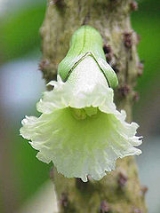
Bignoniaceae
Overview
The Bignoniaceae, or Trumpet Creeper Family, is a family
of flowering plant
s comprising about 650-750 species in 116-120 genera
. Members of the family are mostly tree
s and liana
s (Podranea and Macfadyena), shrub
s and more rarely herbaceous plant
s. As climber plants, they are twine climbers
or tendril climbers
, and rarely root climbers
. Most lianas are found in tribe Bignonieae, that alone contains nearly half the number of species of the family. The family and its genus Bignonia
was named after Jean-Paul Bignon
by his protégé Joseph Pitton de Tournefort
in 1694.
Other common names for this family include jacaranda family, bignonia family or catalpa family.
Family (biology)
In biological classification, family is* a taxonomic rank. Other well-known ranks are life, domain, kingdom, phylum, class, order, genus, and species, with family fitting between order and genus. As for the other well-known ranks, there is the option of an immediately lower rank, indicated by the...
of flowering plant
Flowering plant
The flowering plants , also known as Angiospermae or Magnoliophyta, are the most diverse group of land plants. Angiosperms are seed-producing plants like the gymnosperms and can be distinguished from the gymnosperms by a series of synapomorphies...
s comprising about 650-750 species in 116-120 genera
Genus
In biology, a genus is a low-level taxonomic rank used in the biological classification of living and fossil organisms, which is an example of definition by genus and differentia...
. Members of the family are mostly tree
Tree
A tree is a perennial woody plant. It is most often defined as a woody plant that has many secondary branches supported clear of the ground on a single main stem or trunk with clear apical dominance. A minimum height specification at maturity is cited by some authors, varying from 3 m to...
s and liana
Liana
A liana is any of various long-stemmed, woody vines that are rooted in the soil at ground level and use trees, as well as other means of vertical support, to climb up to the canopy to get access to well-lit areas of the forest. Lianas are especially characteristic of tropical moist deciduous...
s (Podranea and Macfadyena), shrub
Shrub
A shrub or bush is distinguished from a tree by its multiple stems and shorter height, usually under 5–6 m tall. A large number of plants may become either shrubs or trees, depending on the growing conditions they experience...
s and more rarely herbaceous plant
Herbaceous plant
A herbaceous plant is a plant that has leaves and stems that die down at the end of the growing season to the soil level. They have no persistent woody stem above ground...
s. As climber plants, they are twine climbers
Vine
A vine in the narrowest sense is the grapevine , but more generally it can refer to any plant with a growth habit of trailing or scandent, that is to say climbing, stems or runners...
or tendril climbers
Vine
A vine in the narrowest sense is the grapevine , but more generally it can refer to any plant with a growth habit of trailing or scandent, that is to say climbing, stems or runners...
, and rarely root climbers
Vine
A vine in the narrowest sense is the grapevine , but more generally it can refer to any plant with a growth habit of trailing or scandent, that is to say climbing, stems or runners...
. Most lianas are found in tribe Bignonieae, that alone contains nearly half the number of species of the family. The family and its genus Bignonia
Bignonia
Bignonia is a genus of flowering plants in the catalpa family, Bignoniaceae. Its genus and family were named after Jean-Paul Bignon by his protégé Joseph Pitton de Tournefort in 1694.-Selected species:*Bignonia capreolata...
was named after Jean-Paul Bignon
Jean-Paul Bignon
Jean-Paul Bignon was a French ecclesiastic, statesman, writer and preacher and librarian to Louis XIV of France...
by his protégé Joseph Pitton de Tournefort
Joseph Pitton de Tournefort
Joseph Pitton de Tournefort was a French botanist, notable as the first to make a clear definition of the concept of genus for plants.- Biography :...
in 1694.
Other common names for this family include jacaranda family, bignonia family or catalpa family.

